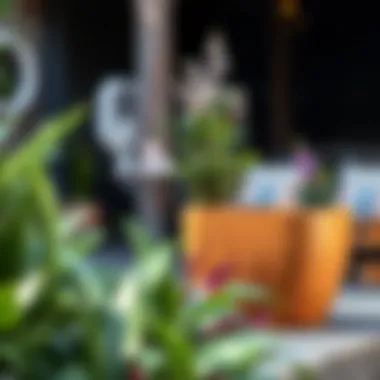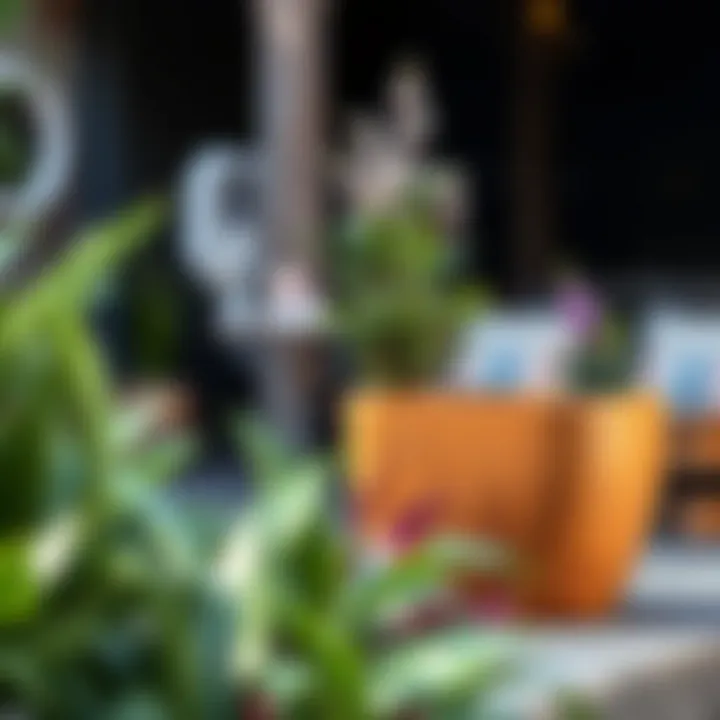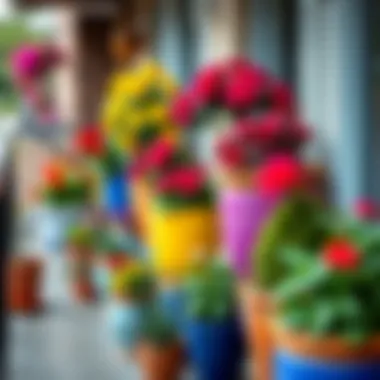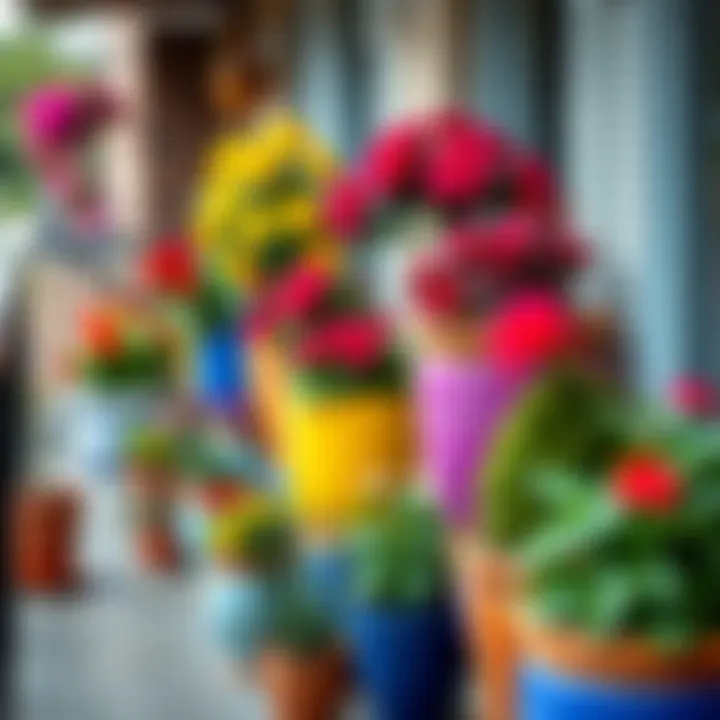At-Home Planter Pots: Design and Practical Guide


Intro
In recent years, the interest in home gardening has surged, transforming living spaces into lush havens. At the core of this movement is the humble planter pot. Whether you're a seasoned horticulturist or just starting to dabble in greenery, the right planter can make a world of difference. Not only do these containers support your plants, but they also serve as key decorative elements, enhancing both indoor and outdoor environments.
This guide aims to walk you through the intricate world of at-home planter pots. We'll dissect various materials, designs, placement strategies, and their roles in elevating aesthetics around your abode. With insights tailored for homeowners, renters, designers, and DIY enthusiasts alike, we hope to inspire a deeper connection with nature right within your walls.
Key topics covered in this exploration include:
- Furniture trends that influence planter design
- Practical DIY projects to craft custom planters
- Tips on selecting the perfect pots for your space
- A discussion on how greenery impacts overall home aesthetics
With this foundation, let’s delve into the fascinating world of planter pots and see how they can breathe life into your surroundings.
Understanding At-Home Planter Pots
In an era where home aesthetics hold as much weight as functionality, understanding at-home planter pots becomes essential for anyone looking to enhance their space with greenery. Planters are not just containers for plants; they're the interface between nature and our living environments, contributing to the overall ambiance of a home. By delving into this subject, one appreciates not only the joy of indoor gardening but also the subtle art of decor that planters offer.
Defining Planter Pots
Planter pots, often referred to simply as planters, serve to hold live plants and soil, creating a supportive environment for growth. They can vary vastly in size, shape, material, and design, ranging from small pots for succulents to large garden containers suitable for shrubs or even small trees. The purpose of a planter pot goes beyond mere containment; it provides necessary drainage, allows for air circulation, and influences the visual appeal of plants. A well-selected planter can complement your home's style, acting as a decorative piece itself.
Furthermore, the choice of planter can significantly impact plant health. From terracotta's porosity that allows for moisture regulation to the insulative properties of ceramic, understanding the types can lead to healthier plants thriving in your care.
The Role of Planters in Home Decor
Once viewed merely as functional items, planter pots today have transformed into crucial elements of home decor. They embody the spirit of indoor gardening while also reflecting personal style. A planter isn't just a pot; it’s a statement. It can be a rustic wooden container that evokes farmhouse charm or a sleek, metallic piece that adds a touch of modernity.
"Plants bring life to space, and the right planter can elevate that impact exponentially."
Consider how planters can delineate spaces within a home. Placing potters in corners, on shelves, or as table centerpieces can create focal points, leading the eye and enhancing spatial flow. Additionally, the various dimensions and colors allow for blending with existing designs or boldly contrasting with them to make a statement.
Homeowners and renters can also benefit from the psychological effects of greenery in their spaces. Studies show that plants can improve mood and reduce stress levels. By selecting unique and visually pleasing planter pots, individuals can turn their homes into tranquil retreats. A cozy corner filled with greenery not only adds to the aesthetics but also creates an inviting atmosphere that feels alive.
Choosing the Right Material
When it comes to selecting planter pots for your home, the material stands as a linchpin in the decision-making process. Each type of material—the backbone of your planters—brings intrinsic qualities that affect both aesthetics and functionality. This section is all about understanding these materials; appreciating their strengths and weaknesses can lead to choices that ultimately enhance your plants’ lives and your home’s vibe.
Ceramic Planters
Ceramic planters are a favorite for many enthusiasts due to their classic appeal and sturdiness. Typically glazed, they come in a spectrum of colors and patterns that can serve as decorative centerpieces or subtle accents. One of the strong suits of ceramic is its ability to retain moisture, which makes it easier to manage watering, especially for plants that prefer a consistent level of hydration. However, there’s a catch: these planters can be quite heavy and potentially prone to chipping if not handled with care.
In areas where temperature fluctuations are common, it's wise to choose frost-resistant ceramics to prevent cracking in colder months. For those who appreciate artisanship, hand-painted ceramics can also tell a story that mass-produced pots can't match, making them unique pieces in your decor.
Plastic Planters
Ah, plastic planters. They’re a mixed bag, often dismissed as unaesthetic, but they pack a punch with their practicality. Lightweight and durable, these pots are often available at budget-friendly prices. They excel in versatility —you can find them in almost every color under the sun. A great benefit here is their resilience against weather elements, making them suitable for outdoor use.
One can even find self-watering varieties that make life easier, particularly for the busy homeowner. However, while they may be easier on your wallet and your back, they don’t often exhibit the same charm as ceramic or wood. But adding your personal touch with paint or stickers can easily transform them into enjoyable decor pieces.
Metal Planters: A Modern Touch
Metal planters are increasingly becoming a go-to for contemporary aesthetics. Materials like galvanized steel and aluminum stand out for their sleek, industrial look, imparting a modern edge to indoor and outdoor settings. They tend to be much more robust, resisting harsh weather conditions while also providing excellent drainage when designed correctly.
On the flip side, metal can heat up quickly in the sun, which might not be ideal for delicate plants that thrive under cooler conditions. Always consider the insulation properties when planning your garden layout; some choose to place them in shaded areas or line them with insulating material to prevent overheating.
Wooden Planters for Natural Aesthetics
Wooden planters bring a little slice of nature indoors, offering warmth that few materials can rival. These planters come in various styles, from rustic logs to smooth, treated timber. Sustainability can also be a focus here, as many are made from reclaimed or ethically sourced wood. They tend to blend seamlessly with natural surroundings—think gardens or patios filled with greenery.
However, wood does require a bit of upkeep. Without proper treatment, they can rot or succumb to pests over time. Regular maintenance, like waterproofing and occasional staining, is crucial to prolonging their lifespan. For DIY lovers, customizing a wooden planter can add a personal flair to your gardening pursuits.


In summary, the choice of material can say a lot about both your personal aesthetics and the welfare of your plants. Consider factors like weight, drainage, moisture retention, and aesthetic appeal to narrow down your options. Every material has its own story to tell—find the one that resonates with your home's spirit!
Design Styles for Planter Pots
Design styles for planter pots play an essential role in determining the atmosphere of your living space. The right design not only complements your interior or exterior decor but also sets the tone for how plants are perceived in your home. Various styles carry distinct aesthetics and emotions, creating a unified theme or making a bold statement. When exploring planter pots, it’s critical to consider how style interacts with functionality, space, and personal taste. A well-chosen planter can enhance the beauty of plants and contribute to a harmonious living environment.
Minimalist Approaches
Minimalism in planter design emphasizes simplicity and functionality. These pots often come in clean lines, subtle colors, and unembellished surfaces. The goal here is to let the plant do the talking while the planter provides a serene backdrop.
- Benefits: Choosing minimalist planters can create a calm atmosphere, helping your plants to stand out. They are often versatile, fitting well into any decor style.
- Considerations: When selecting a minimalist pot, one must ensure it complements the plant's shape and size. The minimalist approach does not favor overly ornate designs, so small plants in clay pots or white ceramics can really shine in this style.
For instance, imagine a small snake plant housed in a sleek black ceramic pot sitting on a white shelf. The absence of distractions draws all eyes to the plant itself, allowing it to be the star of the show.
Vintage and Rustic Styles
Vintage and rustic styles evoke feelings of nostalgia and warmth, often utilizing materials like wood, terracotta, or distressed metal to add character. These planters are not just containers; they tell stories and resonate with charm.
- Benefits: They infuse your home with a sense of history and comfort. Additionally, rustic planters can blend beautifully with natural landscapes, enhancing outdoor gardens.
- Considerations: Care should be taken to choose the right vintage piece. A weathered pot may suit an outdoor setting, but it might look out of place indoors. A vintage planter filled with cascading ivy can be a delightful statement on a patio, bringing a touch of nature that feels timeless.
Think about a large, chipped terracotta pot filled with vibrant geraniums. The pot’s age adds an authentic touch that modern designs often lack, creating a welcoming feel.
Contemporary and Funky Designs
If you have a taste for the avant-garde, contemporary and funky planter designs may be your cup of tea. These planters often feature bold colors, innovative shapes, and artistic patterns that challenge traditional notions of what a planter should be.
- Benefits: These designs can serve as conversation starters. Adding a quirky planter to your space gives it an unexpected twist and reflects a playful or modern aesthetic.
- Considerations: While funky designs are alluring, they require careful pairing with other decor items. A flamingo-shaped planter might overpower a simple room, so it’s essential to balance boldness with subtle design elements.
Picture a vibrant, geometric pot with splashes of color housing a trendy succulent in the corner of your living room. It not only captures attention but also showcases your unique style, breathing new life into the aesthetic of the area.
"The right planter does more than just hold soil; it breathes life into the environment, bridging the gap between nature and human-made spaces."
Whether you lean towards minimalism, rustic charm, or contemporary flair, understanding design styles for planter pots helps you create meaningful connections within your space. Taking the time to evaluate how these styles align with your overall decorative scheme is an investment in your home ambiance.
Functional Considerations
When it comes to at-home planter pots, the nitty-gritty of functionality can’t be overlooked. While aesthetics often steal the limelight—new patterns, color mash-ups, and eye-candy materials—functionality is the unsung hero that keeps your leafy companions thriving. Understanding how features like drainage, size, and placement affect the well-being of plants can transform your approach to home gardening.
Drainage and Soil Management
Getting drainage right is like hitting the sweet spot in baking; too much or too little can ruin the whole thing. Planters need proper drainage to prevent water from pooling, which can lead to root rot—a fate no plant wants to face. Look for pots with holes at the bottom, or consider self-watering options that balance moisture while giving roots room to breathe.
"The right amount of water is as crucial as the right amount of sunlight. Either can spell success or failure for your plants."
The type of soil is just as significant. You wouldn’t hire a new chef without checking their experience in the kitchen, would you? Similarly, selecting suitable soil for your plants ensures they get the right nutrients. For example, succulents enjoy a gritty, well-draining mix, while tropical plants may prefer a heavier, moisture-retaining substrate. Regularly checking soil moisture levels can prevent under- or over-watering, giving your plants their best shot at thriving.
Size and Scale for Different Plants
Talk about making a statement! The size of your planter can either elevate your plants or stifle their growth. It’s essential to choose pots that offer enough room for roots to grow but aren’t so large that the plant drowns in soil. A small fern in a giant pot looks lost and out of place, while a thriving monstera needs ample space to stretch out.
Consider the mature size of your plants—not just what they look like at the time of planting. A little planning ahead can save you from having to repot down the line, which can disrupt root systems and stunt growth.
Some considerations for choosing sizes:
- Small Plants: Can go into pots around 4-6 inches.
- Medium Plants: Opt for around 6-12 inches.
- Large Plants: Look for pots that are at least 12 inches or more, allowing for spacious roots.
Placement Strategies Around the Home
The best planter in the world can flop if it’s in the wrong spot. Thoughtful placement takes into account not just the best aesthetics, but what each plant craves in terms of light. A North-facing window might not be the best home for a sun-loving cactus, while shade-loving ferns will thrive in far less light.
Individual rooms can dictate placement, too. If you’re trying to create a tropical paradise in your bathroom, a few humidity-loving plants near the shower can do wonders for that vibe. In contrast, a sunny living room might welcome an array of succulents to brighten up the space.


Tips for Smart Placement:
- High Light Areas: South-facing windows work wonders for sun-loving plants.
- Low Light Spots: Choose plants like snake plants or pothos that can thrive in indirect light.
- Air Quality Improvement: Certain plants can purify air; place them in common areas for maximum effect.
Ultimately, the blend of functional considerations ensures that your home does more than just look good; it becomes a nurturing environment for your green inhabitants.
Caring for Your Planter Pots
Taking care of your planter pots is not just a question of aesthetics; it’s about ensuring your plants thrive in a nurturing environment. When planter pots are properly cared for, they contribute significantly to the health of your green companions, creating a lush atmosphere in any space, whether indoor or outdoor. Neglecting maintenance can lead to several issues, including disease, poor drainage, and ultimately, a failure to flourish.
Cleaning and Maintenance Tips
Maintaining a clean planter is crucial to your plants' health. Dust, algae, and residues can accumulate over time, blocking drainage holes and even fostering pathogens. Regular cleaning helps prevent these issues. Here are some practical tips:
- Regular Wipe-Downs: A simple and effective technique is giving your pots a wipe-down with a damp cloth weekly. This keeps dust and dirt from becoming a bigger issue.
- Choose the Right Cleaner: If your pots are particularly dirty, consider using a mixture of mild soap and water. Avoid harsh chemicals as they can leave residues that may harm your plants.
- Clay and Terracotta Special Care: These materials are porous and can absorb dirt. Occasionally soaking them in warm, soapy water followed by a thorough rinse can do wonders.
- Disinfecting Solutions: For ceramic or plastic pots, a diluted solution of bleach or vinegar (one part to ten parts water) can help eliminate mold and other harmful microbes. Be sure to rinse thoroughly after to remove any residue.
- Inspect for Damage: While cleaning often, examine your pots for cracks or breaks that could allow for leaks. Patch these if possible or replace the pots if not.
"A well-maintained planter not only beautifies a space but significantly boosts the vitality of its botanical inhabitants."
Seasonal Care for Indoor vs. Outdoor Planters
The emphasis on seasonal care is indispensable when keeping your plants vibrant throughout the year. Indoor planters tend to endure stable, controlled conditions, while outdoor planters face the whims of nature's elements. Here’s how to approach each:
- Indoor Planters:
- Outdoor Planters:
- Winter Care: As temperatures drop, indoor heating can dry the air. Monitor humidity levels and consider occasional misting for tropical plants. Also, reduce watering since most plants require less during dormancy.
- Summer Attention: Be vigilant about watering more frequently when the sun shines strong. Calcium buildup can occur in pots, so consider rotating the pots occasionally to promote even growth.
- Spring Awakening: With the bloom of spring, your outdoor plants need some TLC. Fluff the soil, remove debris, and ensure drainage holes are clear to allow for rainwater drainage.
- Fall Preparations: As winter approaches, transition with mulch to insulate roots. Group pots together to protect them from harsh winds and freezing temperatures.
In both cases, keeping an eye on symptoms of stress—such as yellow leaves or wilting—can aid in the timely adjustment of care routines. Noticing changes and adapting is the name of the game in keeping your plants in prime condition.
Sustainable Choices in Planting
In today's world, where environmental consciousness is on the rise, making sustainable choices in planting is more than just a trend; it's a necessity. Everyone, including homeowners, renters, and designers, is increasingly aware of the impact their choices have on the planet. Opting for sustainable planter options not only contributes to conserving resources but also enhances the visual appeal of your living spaces. This section delves into two critical aspects of sustainability—the use of recycled and eco-friendly materials and the ethical sourcing of planters.
Recycled and Eco-Friendly Materials
Choosing planter pots made from recycled and eco-friendly materials is a proactive step towards reducing waste. Many traditional materials, such as plastic, can take centuries to decompose. In contrast, using recycled materials helps minimize landfill contributions. For instance, planters made from recycled plastics or upcycled wood can offer both functionality and style without leaving a hefty ecological footprint.
- Benefits of Using Recycled Materials:
- Reduces Resource Extraction: Utilizing materials that already exist decreases the demand for new raw materials.
- Lower Carbon Footprint: The energy needed to create new products from scratch is typically higher than that required to recycle existing products.
- Cost-Effective: Many recycled materials can be more affordable than their new counterparts.
Consider planters crafted from materials like bamboo, which is both renewable and biodegradable. Alternatively, certain brands incorporate recycled ocean plastics into their planters, successfully giving them a second life while addressing marine pollution issues. The increasing availability of these options provides an excellent opportunity for individuals to contribute positively to environmental preservation.
Ethical Sourcing of Planters
The journey towards sustainability does not stop at the materials; ethical sourcing is just as paramount. When purchasing planters, look for brands that prioritize ethical labor practices and sustainable harvesting. This not only ensures that materials are responsibly obtained but also supports fair treatment and wages for workers involved in the manufacturing process.
- Key Points in Ethical Sourcing:
- Transparency: Choose brands that share information about their sourcing practices. Knowing where and how a product is made can help consumers make informed decisions.
- Supporting Local Economies: Whenever possible, opt for locally sourced planters. This supports nearby artisans and minimizes transportation emissions.
- Certifications: Look for certifications like Fair Trade or those from environmental protection agencies, which can signal a commitment to ethical practices.
"Sustainable choices in planting don’t just benefit your home; they positively impact the community and environment at large."
Incorporating sustainably sourced planters not only beautifies your space but elevates your overall lifestyle. By understanding the importance of recycled materials and ethical sourcing, you empower yourself to make choices that reflect a commitment to a better future—one planter at a time.
Customizing Your Planter Experience
Customizing your planter experience goes beyond mere aesthetics; it creates a connection between you and your plants while enhancing your living space. By personalizing your planters, you tap into your creativity, transforming each pot into a reflection of your unique style and a conversation starter. It's not just about making your environment visually appealing; it’s also about embedding yourself in the gardening journey.


DIY Planter Pot Projects
Embarking on DIY planter pot projects can serve as a gratifying way to engage with your green thumb. Not only do these projects allow for creativity, but they also present an opportunity to recycle and re-purpose materials that may otherwise end up in the landfill. Here are some engaging ideas:
- Using Upcycled Containers: Old tins, jars, or teacups can all be transformed into charming pots. Not only does this give these items new life, but it also provides a rustic, vintage flair to your plant display. For example, an old wooden crate can make an attractive planter for a herb garden on your balcony.
- Creative Plant Stands: Building a simple wooden stand or shelf from reclaimed wood to hold multiple planters can elevate your plants while adding a rustic style. This design not only saves space but also showcases your plant collection to its fullest potential.
- Hand-Painted Planters: Personalizing plain ceramic pots with your favorite colors and designs allows you to express your artistic flair. Use acrylic paints to create patterns, or gather some friends for a fun painting party where everyone decorates their own pot.
These projects bring a sense of accomplishment, and they can be enjoyed with family or friends, creating memorable experiences in the process.
Personalizing Planters with Paint and Decor
Personalizing planters through paint and decor opens a treasure trove of possibilities. Well-chosen colors and designs contribute significantly to the overall appearance of your plants, complementing their natural beauty. Here’s how to go about it:
- Choosing Colors: Selecting hues that resonate with your home’s décor or your personal taste can unify a space. For example, if your living room has earthy tones, consider muted greens or browns for the pots, enhancing the room's warm feeling. Alternatively, bold colors like teal or mustard yellow can inject energy into otherwise subdued spaces.
- Using Patterns: Stripes, dots, or floral motifs—patterns can add depth and interest. This not only makes for an eye-catching design but also allows personal expression. If you’re unsure, stencils can help achieve a professional look without the need for advanced skills.
- Accessorizing: Beyond paint, think about curtains, ribbons, or yarn. Wrapping a planter in burlap or decorating with twine gives it a homespun charm. You can also attach small chalkboard labels to identify plants or even write little notes.
"A little creativity can transform the most mundane pot into a stunning focal point in any room."
By leaning into your personal touch, you are not just adorning a planter; you are creating an environment that resonates with who you are.
Overall, customizing your planter experience encourages creativity, enhances your living space, and fosters a deeper connection with gardening. Engaging in DIY projects or personalizing planters with paint and decor transforms not only your plants but your entire home.
Planters and Home Aesthetics
Planters are more than just containers; they are vital accessories that can significantly alter the essence of a room. When chosen with intent, planter pots can enhance a space's character, making it feel more inviting and alive. Integrating greenery into home decor serves not simply a practical purpose, but also adds dimension and warmth. Plants draw the eye, and their positioning can dictate the flow of energy in a room.
Integrating Planters into Different Rooms
Different spaces in a home call for tailored approaches when it comes to using planters. In living rooms, large ceramic pots housing vibrant foliage can become focal points, offering an organic contrast to furniture. Placing smaller pots on windowsills or side tables can create layers that enhance visual interest.
In bedrooms, the choice of plants can impact the atmosphere significantly. Calming greens like snake plants or peace lilies can improve air quality while also adding a serene touch when placed on nightstands or dressers. The materials also matter; wooden planters can contribute to a cozy, rustic feel, which may be preferred for such a personal space.
Kitchens can be just as lively with plants; herbs in small pots on countertops or hanging planters near windows not only look good but also provide culinary benefits. Imagine fresh basil or mint at arm’s reach while cooking. It’s practical and appealing.
In bathrooms, humidity-loving plants, such as ferns or pothos, do exceptionally well, making them ideal choices for such spaces. A hanging planter can save counter space while introducing a bit of nature to a traditionally sterile environment.
Creating Cohesive Look with Color and Texture
The key to achieving a harmonious aesthetic is by paying attention to color and texture. Cohesion in a home's design is often derived from balanced elements. For planters, selecting containers that complement the room's color palette or textures can unify different aspects of decor.
- Color Coordination: Using warm-toned planters with earthy plants can create a soothing environment, while vibrant colored pots can energize a space. Consider matching the pot colors with accent walls or furniture.
- Texture Contrast: Mixing textures can also create visual intrigue. For example, a sleek metal planter combined with a rough-hewn wooden table can create a dynamic that engages the eye.
- Patterns and Designs: Introducing patterned planters alongside blank wall spaces or minimalistic furniture can create a striking focal point without overwhelming the viewer.
By thoughtfully integrating planters into various rooms and considering color and texture, homeowners can elevate their spaces, transforming their indoor environments into sanctuaries of style and life.
"The plants you choose and how you display them can drastically change the character of your home, creating diverse atmospheres in different rooms."
Ultimately, the aesthetic of a space heavily relies on the subtle details, and planters are an accessible means to add depth and charm.
Innovative Planter Trends
As we navigate the evolving landscape of home design, innovative planter trends emerge as pivotal elements in transforming our living spaces. The intersection of technology, sustainability, and aesthetics in planter design has opened up avenues for both functionality and style in home gardening. By integrating these cutting-edge features, homeowners can elevate not just the look of their spaces but also enhance the plant care experience. This section highlights how modern planter trends can cater to various lifestyles and home settings, making gardening more accessible and engaging.
Vertical Gardens and Hanging Planters
Vertical gardens and hanging planters have redefined urban gardening by maximizing space and infusing life into areas where conventional pots wouldn’t fit. They are more than just a passing craze; they represent a sophisticated approach to integrating greenery into our lives. These setups can bring a splash of color to blank walls or empty corners, effectively converting unused vertical space into a lush garden oasis.
- Space-Saving Solution: Vertical gardens are an ideal choice for small apartments and restricted outdoor areas. By utilizing trellises or wall-mounted planters, one can create a green wall that serves as a stunning backdrop while saving valuable floor space.
- Aesthetic Appeal: Hanging planters also contribute to the decor. Imagine trailing ivy cascading from a high shelf or vibrant flowers bobbing gently by the window. The varied heights and textures contribute depth and interest.
- Ease of Access: The positioning of vertical and hanging planters allows for easy maintenance, especially for herbs or high-sun plants that require regular care. Having them at eye level makes watering and pruning hassle-free.
However, there are important factors to consider, like ensuring proper sunlight exposure and choosing suitable plants that will thrive in these conditions. Also, consider the watering methods to prevent excess moisture from damaging your walls or floors.
"In a world where space is gold, vertical gardening offers a way to elevate your home’s connection to nature without breaking the bank or your back."
Smart Planters with Technology Integration
Smart planters are fundamentally revolutionizing how we think about nurturing plants at home. These high-tech innovations can range from simple self-watering systems to fully automated greenhouses bonded with sensors and data analysis tools.
- Automated Care: Smart planters can monitor soil moisture, light levels, and even temperature. This information is relayed to a phone app, making plant care almost effortless. For those who often forget to water or don’t know how much light their plants need, these devices can bridge the gap between no knowledge and a flourishing garden.
- Data Tracking: Integration with technology allows for data logging over time, providing insights into growth patterns and optimal conditions for each type of plant. This can greatly aid in understanding plant care needs, especially for newbies.
- Eco-Friendly Features: Many smart planters are designed with sustainability in mind. Energy-efficient systems and those that utilize recycled materials can contribute to a greener environment while keeping your home stylish.
While embracing smart planters, it’s worth noting that initial investment can be higher than traditional options. Yet, the long-term benefits of reduced plant mortality rates and enhanced growth through optimized conditions can often outweigh the costs.















